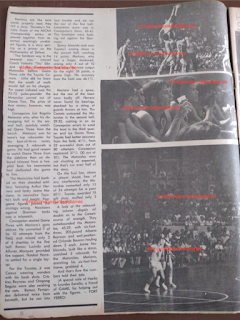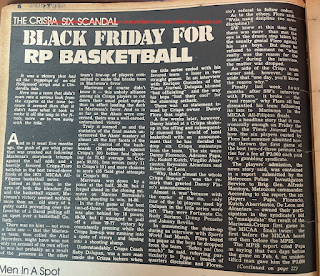Sports World Magazine
July 21, 1973
It
was a victory that had all the trappings of an old Hollywood script and
Cinderella tale.
Here was a team that
didn’t even rate a serious look from the experts at the time because it seemed
then that it didn’t have what it took to make it all the way to the finals,
more so to run away with the title.
And so it went five months ago, the
gush of gee whiz prose that was cranked out following Mariwasa’s storybook
triumph against the tall odds and a heavily-favored Crispa-Floro ballclub in
the best two-of-three finals of the 1973 MICAA All-Filipino basketball series.
Indeed, at that time, in the eyes of
both the bleacher fan and the basketball expert, Mariwasa’s victory seemed
nothing more than an old story of a gutsy outfit prevailing over the favorite;
of a David pulling off an upset over a basketball Goliath.
There was no hint – not even a faint
one – that the Mariwasa team, then called the Akai Recorders, might have won
not only on account of its own effort to win but probably as a result of the
presence in the other team’s linup of players committed to make the breaks turn
into Mariwasa’s favor.
Mariwasa, of course, didn’t know it
– this unholy alliance among six Crispa players to cut down their usual point
output, thus, in effect, loading the deck in Mariwasa’s favor. And so, in so
far as the Akais were concerned, theirs was a well-earned, untarnished victory.
Truly, it seemed so and the
statistics of the final match underscored the Akais’ mastery almost all the key
facets of the game – control of the backboards (34 rebounds against Crispa’s
30), better foul shooting (a 71.42% to Crispa’s 55.55%), less errors (only 11
to Crispa’s 15), and more chances to score (85 field goal attempts to Crispa’s
66).
Mariwasa was down by a point at the
half, 38-39, but it forged ahead in the closing minutes on Narciso Bernardo’s
clutch shooting to win, 84-80.
In the first game of the best
two-of-three series, Mariwasa was also behind by 10 points, 49-39, but it
managed to pull off a close 79-77 victory by consistently pressing while the
Crispa lineup was running into a spate of errors and lapsing into a shooting
slump.
Understandably, Crispa Coach Baby
Dalupan was a sore man inside the Crispa lockers when the title series ended
with his favored team a loser in two straight games. In an interview with
Enrique Gonzales of the Times Journal, Dalupan blamed “bad officiating” and the
way his boys “lost their cool” for the stunning setback.
There was no statement issued by
Crispa owner Danny Floro that night.
A few weeks later, however, Danny
hinted at a Crispa shakeup in the offing and subsequently stunned the world of
local basketball with an announcement that he has decided to drop six Crispa
mainstays from the team. The six were Danny Florencio, Adriano Papa, Jr.,
Rudolf Kutch, Virgilio Abarrientos, Reynaldo Alcantara and Ernesto de Leon.
“Why, that’s almost the whole Crispa
lineup!” was the remark that greeted Danny Floro’s announcement.
Almost it was because with the
ouster of the six, only four of the ten players used by Dalupan in the title
series were left. They were Fortunato Co, Rudy Soriano, Danny Pecache, and
Johnny Revilla.
In announcing the shakeup during an
interview with Sports World last March, Floro bared his pique at the boys he
dropped from the team. “Sobra na!
(too much),” he said, referring particularly to Papa’s breach of quarters
discipline and Florencio’s refusal to follow orders.
As to the others, Floro said “wala nang disiplina (no more
discipline).”
SW knew at this time that there was
more than met the eye in the drastic step taken by the usually genial Floro
against his six boys. But since he refused to comment on “what really was the
reason for the ouster” during the interview, the matter was dropped.
An aide of the Crispa team owner
said, however, in an aside that “one day, you’ll know the reason why.”
Finally, last week, four months
after SW’s interview with Floro, it broke – the “real reason” why Floro all but
dismantled his team following its loss to Mariwasa in the MICAA All-Filipino
finals.
In a headline story that it ran,
ironically enough on Friday the 13th, the Times Journal bared how
the six players ousted by Floro last summer admitted having thrown the first
game of the best two-of-three pennant series for a fee of Php 3,000 each paid
by a gambling syndicate.
The players’ admission, the news
story said, was contained in a report submitted by the Metrocom Police Investigation
Service to Brig. Gen. Alfredo Montoya, Metrocom commander. According to the
report – Papa, Florencio, Kutch, Abarrientos, De Leon and Alcantara – owned
their participation in the syndicate’s bid to “manipulate” the result of the
Mariwasa-Crispa first game in the MICAA finals twice: the first before the
MICAA board then before the MPIS.
The MPIS report cited Papa as saying
that two days before the game on February 4, an unidentified man gave him the
Php 3,000 in his residence. He was asked to contact the other players. In his
statement, Papa also reportedly disclosed that “anomalies in bigtime basketball
went on even during the time of Carlos Loyzaga and Lauro Mumar.”
Concluding its report, the MPIS said
“the gravity of the offense was such that it undermined the faith of the
Filipino people in the No. 1 sport in the country.”
Expectedly, the scandal, the first
to hit local basketball, touched off a wave of anger and concern among
basketball officials and the media. Councilor Lito Puyat, president of the
Basketball Association of the Philippines, convened the 21-man BAP board to a
meeting to decide on the sanctions that it would take against the erring
cagers.
PAAF President Ambrosio Padilla, a
former Olympic basketball player, bemoaned the incident. “It is a very sad day
for Philippine basketball,” he said, “but the best we can do now is to do
everything possible to avoid a repetition of such a case.”
MICAA President Domingo Itchon
served noticed that the association intended to take a hard line against the
six former MICAA players. “Any penalty is to be imposed on this case should be
more severe than a life suspension (from basketball),” Itchon said.
Acting swiftly to head off the
threatening erosion of public confidence in its basketball circuit, the MICAA
board slapped a permanent ban on the six erring players and decided to pursue
further investigation of other players reported to have committed the same act
of dishonesty.
In another move, the MICAA also
reminded all the league’s team managers, coaches and players of its rule
prohibiting “an official, coach, player, referee, umpire or those connected
with the game in some capacity from betting.” Violation of this rule, the MICAA
said, will bar the individual concerned from further participation in any game.
The MICAA decision to expand its
inquiry into the first scandal ever to hit its popular basketball league
apparently stemmed from a disclosure by Capt. Hector Alvarez of the MPIS that
“five other Crispa boys” are also involved in the fix.
Capt. Alvarez, who handled the
investigation of the scandal, said: “It was established during our
investigation of the six Crispa players that five other Crispa boys also
received something but no action had been taken against them because our
investigation was centered on Papa and his companions.”











